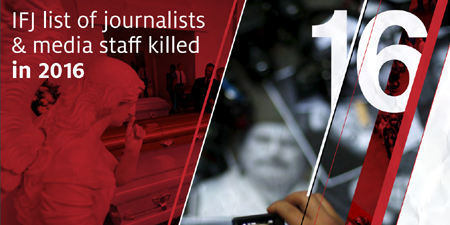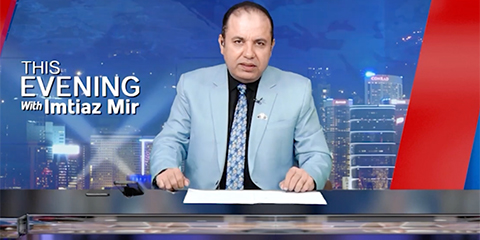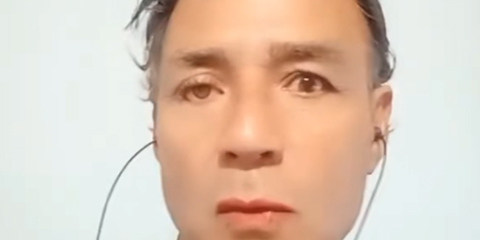
PFUJ calls for end to Impunity for Crimes Against Journalists
November 02, 2025: PFUJ urges Pakistan’s federal and provincial governments to end Impunity for Crimes Against Journalists and ensure their safety and press freedom.
JournalismPakistan.com | Published 8 years ago
Join our WhatsApp channel
The International Federation of Journalists (IFJ) Thursday launched the IFJ list of journalists and media staff killed in 2016, documenting the deaths of colleagues killed in the line of duty.
In the Asia-Pacific region, 28 journalists were brutally murdered in 2016, an increase from 2015. The report, which is now in its 26th year, is a key tool in the IFJ’s continued efforts to tackle impunity for crimes against journalists and campaign for greater safety.
In the Asia Pacific region, there have been some wins, but with each comes a devastating blow to the efforts made to secure the safety of journalists worldwide. In the last two years, the IFJ Asia-Pacific cautiously noted a marked reduction in media killings in Pakistan. While actions in Pakistan to tackle journalist fatalities and shocking impunity levels finally seem to be making some difference, the situation in neighbouring Afghanistan and India is taking a worrying trajectory.
Afghanistan is now our region’s frontline, with 13 journalists brutally murdered in 2016. The year started with the loss of seven media workers from Tolo TV in a suicide bomb attack on their transport van as they left work on January 20. The incident occurred after sustained threats by the Taliban on the news outlet for its media coverage of the Taliban takeover of Kunduz the year prior. Another 25 civilians were wounded in the same attack.
The situation in India has also deteriorated in the past 12-18 months, with five journalists killed in 2016, taking the total to 40 in the past five years. What is becoming clear in the case of India is that despite being the world’s biggest democracy, freedom of expression and critical reporting increasingly has a murderous price.
IFJ Director – Program & Development, Jane Worthington, said: “Across the Asia Pacific region, 28 journalists and media workers lost their lives on duty in 2016 – accounting for a quarter of all media deaths recorded by IFJ globally in the year. Most were gunned down in direct attacks. Many of them were reporting on the toughest issues: illegal mining and forestry, corruption, black market activities, political and criminal mafia operations.”
Hard-fought wins have been achieved in Sri Lanka, the Philippines and Pakistan in the past 12 months which give hope about the continued work across the globe. The reopening of investigations into the murder of Lasantha Wickremetunge in Sri Lanka; and convictions in the murders of Ayub Khattak in Pakistan and Desiderio Camangyan in the Philippines, illustrate what can be achieved through consistent campaigns, solidarity action and collaborative effort.
“But as long as these are the exception rather than the rule and we continue to lose a journalist to murder every 13 days, we still have the greatest challenges before us,” said the IFJ. - IFJ media release

November 02, 2025: PFUJ urges Pakistan’s federal and provincial governments to end Impunity for Crimes Against Journalists and ensure their safety and press freedom.

November 02, 2025: Impunity for crimes against journalists deepens worldwide as Pakistan reports a 60 percent surge in attacks and weak enforcement of safety laws.

November 01, 2025: Pakistan Press Foundation reports 137 attacks on journalists in 2025, highlighting rising threats, legal harassment, and censorship on the International Day to End Impunity.

November 01, 2025: A viral Samaa TV clip featuring MNA Sher Afzal Marwat’s crude remarks and Talat Hussain’s laughter raises questions about the declining ethics of Pakistani television.

October 31, 2025: Police foiled a plot to kill DawnNewsTV journalist Tahir Naseer in Rawalpindi after arresting suspects hired for Rs200,000. Naseer says threats followed his reporting.

October 31, 2025: CPJ calls on Pakistan to bring Imtiaz Mir’s killers to justice after the journalist was allegedly murdered by a banned militant group in Karachi.

October 30, 2025: The PFUJ has condemned a fabricated drug case against journalist Matiullah Jan, calling it an attempt to silence him and urging authorities to quash the charges immediately.

October 30, 2025: NewsOne TV remains on air but faces mass layoffs and delayed salaries, exposing Pakistan’s worsening media crisis and financial instability.

November 02, 2025 Independent outlet All About Macau to halt print and online operations amid rising pressure, financial strain, and legal threats, sparking press freedom concerns in the city.

November 01, 2025 Belarus court jails journalist Siarhei Chabotska for extremism and defaming the president, highlighting Minsk’s ongoing crackdown on press freedom.

November 01, 2025 Mexican journalist Miguel Angel Beltran was found murdered in Durango. CPJ urges authorities to ensure justice amid rising violence against journalists in Mexico.

November 01, 2025 UNESCO survey finds one-third of media lawyers cannot effectively defend journalists due to threats, limited resources, and lack of specialization.

October 31, 2025 Radio Free Asia, a US government-funded broadcaster covering tightly controlled Asian media environments, has suspended all news operations after federal funding dried up.